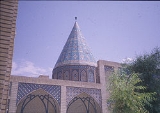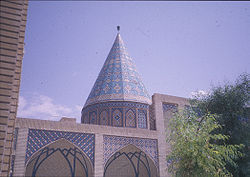
Pirouz Nahavandi
Encyclopedia
- For the seventeenth Sassanid King of Persia see Peroz IPeroz IPeroz I Peroz I Peroz I (also Pirooz; Peirozes (Priscus, fr. 33); Perozes (Procopius, De Bello Pers. I. 3 and Agathias iv. 27; the modern form of the name is Perooz, Piruz, or the Arabized Ferooz, Firuz; Persian: پیروز "the Victor"), was the seventeenth Sassanid King of Persia, who ruled from 457...
.
Pirouz Nahavandi (or Piruzan) (also known as Abu-Lu'lu'ah al-Nahawandi ) was a Persian Zoroastrian
Zoroastrianism
Zoroastrianism is a religion and philosophy based on the teachings of prophet Zoroaster and was formerly among the world's largest religions. It was probably founded some time before the 6th century BCE in Greater Iran.In Zoroastrianism, the Creator Ahura Mazda is all good, and no evil...
soldier who served under the commander Rostam Farrokhzad
Rostam Farrokhzad
Rostam Farrokhzād was the Ērān Spāhbod of the Sāsānian Empire under the reign of Yazdgird, r. 632 - 651...
, but was captured in the Battle of al-Qādisiyyah
Battle of al-Qadisiyyah
The Battle of al-Qādisiyyah was fought in 636; it was the decisive engagement between the Arab muslim army and the Sassanid Persian army during the first period of Muslim expansion. It resulted in the Islamic conquest of Persia, and was key to the conquest of Iraq...
in 636 CE
Common Era
Common Era ,abbreviated as CE, is an alternative designation for the calendar era originally introduced by Dionysius Exiguus in the 6th century, traditionally identified with Anno Domini .Dates before the year 1 CE are indicated by the usage of BCE, short for Before the Common Era Common Era...
when the Persians were defeated by the Arab-Muslim army of Caliph
Caliph
The Caliph is the head of state in a Caliphate, and the title for the ruler of the Islamic Ummah, an Islamic community ruled by the Shari'ah. It is a transcribed version of the Arabic word which means "successor" or "representative"...
`Umar
Umar
`Umar ibn al-Khattāb c. 2 November , was a leading companion and adviser to the Islamic prophet Muhammad who later became the second Muslim Caliph after Muhammad's death....
ibn al-Khattâb on the western bank of the Euphrates
Euphrates
The Euphrates is the longest and one of the most historically important rivers of Western Asia. Together with the Tigris, it is one of the two defining rivers of Mesopotamia...
River. After he was brought to Arabia as a prisoner, he managed to assassinate Umar
Umar
`Umar ibn al-Khattāb c. 2 November , was a leading companion and adviser to the Islamic prophet Muhammad who later became the second Muslim Caliph after Muhammad's death....
in the Muslim year 23 (644–645 CE).

Early life
Not much is known about Piruz, except that judging by his name, he was probably born in Nahavand, Iran, and was a Zoroastrian or Agnostic convert to IslamIslam
Islam . The most common are and . : Arabic pronunciation varies regionally. The first vowel ranges from ~~. The second vowel ranges from ~~~...
.
Move to Medina
In addition to his superb military skills, Pirouz was a skilled workman, a carpenter and artisan, and his owner allowed him to live in his own household in the Islamic capital of MedinaMedina
Medina , or ; also transliterated as Madinah, or madinat al-nabi "the city of the prophet") is a city in the Hejaz region of western Saudi Arabia, and serves as the capital of the Al Madinah Province. It is the second holiest city in Islam, and the burial place of the Islamic Prophet Muhammad, and...
(although according to Ibn Sa'd, Mughira ibn Shu'ba
Mughira ibn Shu'ba
al-Mughīrah ibn Shuʿbah ibn Abī ʿĀmir ibn Masʿūd ath-Thaqafī was one of the more prominent companions of Muhammad.-Muqawqis:Mughira had a dialogue with both Muqawqis, Vicegerent of Egypt and Caesar.Mughira was impressed by the dialogue with Muqawqis...
, his owner who was also the governor of Basra
Basra
Basra is the capital of Basra Governorate, in southern Iraq near Kuwait and Iran. It had an estimated population of two million as of 2009...
, had written 'Umar from Kufa; and then 'Umar had given Mughira special permission to send Abu Lu'lu'ah to Medina—since captives were not permitted to live in Medina).
Some controversial stories (all stemming from one Arab source) say that Abu Lu'lu'ah hired himself out as a carpenter, and gave two dirham
Dirham
Dirham or dirhem is a unit of currency in several Arab or Berber nations, and formerly the related unit of mass in the Ottoman Empire and Persian states...
s a day to his owner in return for his limited freedom [while Ibn Shihab's account states that every month Mughira took 100 dirhams from his wages (although the account of Abu Huwayrith, also in Ibn Sa'd's Tabaqat, states 120 dirhams, four per day)]. He supported a wife and child on the rest of his earnings.
Umar's murder
One controversial story [which summarizes and is largely in agreement with the account (ultimately deriving from Ibn Shihab) included by Ibn Sa'd in his Tabaqat] goes thus: Abu Lu'lu'ah felt that he had to give too much of his wages to his owner. He approached Umar, the caliph, and begged for relief, saying (according to Abu Huwayrith's account in Ibn Sa'd's Tabaqat) "The taxes [Mughira] are levying on me are more than I can bear." Mughira (his owner), as a Muslim, was subject to Umar; surely Umar could enforce justice.However, Umar, after questioning him about how much his income was in proportion to the tax that Mughira was demanding from him (according to Ábu Huwayrith), told Abu Lu'lu'ah that he was such a skilled workman that he was sure to make a good wages; there was no need to reduce his obligation to his owner. That did not satisfy Piroz, and he went away sulking. There were Persian children slaves in Madina. Seeing them, Piroz would say, "You have been enslaved at such a tender age. This Umar sees eaten my heart. I will take his heart out". He made for himself a dagger with a very sharp edge and smeared it with poison.
[Ibn Sa'd adds: So in his robe he wrapped his two-headed dagger, the grip of which was in the middle, and hid himself in a corner of the Medina mosque.
When Umar went to wake up those sleeping in the mosque for morning prayers, Abu Lu'lu'ah leaped upon him and stabbed Umar six times [three times, according to Ibn Sa'd]. He attempted to make his way out of the mosque, slashing at the bystanders [11 men besides 'Umar, according to Ibn Sa'd] as he fled.
Death
There are different narrations of how he died. Bukhari's SahihSahih al-Bukhari
Ṣaḥīḥ al-Bukhārī , as it is commonly referred to, is one of the six canonical hadith collections of Islam. These prophetic traditions, or hadith, were collected by the Persian Muslim scholar Muhammad ibn Ismail al-Bukhari, after being transmitted orally for generations. Muslims view this as one of...
states that he killed himself when he got caught minutes after murdering Umar. The Shia say he escaped and ended up in Kashan
Kashan
Kashan is a city in and the capital of Kashan County, in the province of Isfahan, Iran. At the 2006 census, its population was 248,789, in 67,464 families....
, where, seven years later, he was captured and killed.
Cultural Figure
Pirouz Nahavandi is regarded by a few Iranians as a National Hero, and as a cultural figure they jokingly associate him with Haji Firouz who ushers in the Iranian New YearNowruz
Nowrūz is the name of the Iranian New Year in Iranian calendars and the corresponding traditional celebrations. Nowruz is also widely referred to as the Persian New Year....
.
Tomb
Pirouz Nahavandi's tomb "is located on the road from KashanKashan
Kashan is a city in and the capital of Kashan County, in the province of Isfahan, Iran. At the 2006 census, its population was 248,789, in 67,464 families....
to Fins, constructed in an eleventh century distinctive Persian-Khwarezmian dynastic architectural style, consisted of a courtyard, porch and conical dome decorated with turquoise coloured tiles, and painted ceilings. The original date of its construction is unknown, but in second-half of fourteen century it was fully restored and a new tombstone was placed over his grave." from the website of the Circle of Ancient Iranian Studies (CAIS).
Controversy was caused recently when the International Union for Muslim Scholars called for the tomb to be destroyed, a request which was not well received by Iranians, even among those who support the Islamic Republic
Islamic republic
Islamic republic is the name given to several states in the Muslim world including the Islamic Republics of Pakistan, Iran, Afghanistan, and Mauritania. Pakistan adopted the title under the constitution of 1956. Mauritania adopted it on 28 November 1958. Iran adopted it after the 1979 Iranian...
, according to the CAIS website, having being perceived as a specifically anti-Iranian act.

